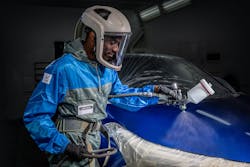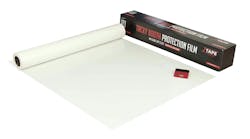One of the many things modern collision repair facilities are driven by is efficiency. Time-per-repair and cost-per-repair are important metrics on the road to success. Paint department efficiency is a vital component for achieving these productivity goals. When considering factors that often affect productivity in the paint shop, many can be traced back to issues related to decisions made early in the refinish process.
Surface preparation, system selection, and application techniques are often primary contributors. By focusing on the value of these simple points, a significant portion of paint shop-related “rework” can be avoided, driving efficiency gains, customer satisfaction, and, ultimately, a more profitable business.
Focus #1: Proper surface preparation
Having a clean and properly prepared substrate is essential for the successful application of coatings. Investigations reveal that contamination is the issue most often attributed to automotive refinish problems. One secret to success here is to thoroughly clean the surface to be painted before sanding or scuffing, ensuring that contaminants are not driven into the substrate.
Cleaning before sanding also makes for easier sanding and extends the life of the sandpaper being used. Some less obvious advantages of a properly cleaned and prepared surface are enhanced color accuracy and reduced paint material usage, along with improved adhesion and application.
Points to consider:
- Always use the appropriate cleaner for the substrate being prepared (e.g., materials such as raw plastics may require a special cleaner).
- When regulations allow, use both water-based and solvent-based cleaners to ensure the best chance of removing all types of contaminants.
- Always surface clean both before and after sanding.
- Use two clean lint-free towels when cleaning; one for applying the cleaner to the surface and the other for wiping the surface dry before the applied cleaner evaporates. Change contaminated towels frequently.
- Always use the manufacturer recommended personal protective equipment (PPE) when handling any cleaning products.
Focus #2: Proper product selection
Selecting the proper paint products for the task is an area that is often taken for granted. Many refinishing issues are resolved through simply choosing the system components that best fit the job size and environment. It is not unusual to discover the root cause of an appearance problem was related to something as seemingly simple as what reducer or hardener was chosen at the time of application. Carefully reading and following the guidance provided in the product Technical Data Sheets (TDS) is the best practice for making the right choices. Adhering to the recommendations in the TDS will ensure that the products listed work together as a system and provide reliable results in both performance and appearance.
Points to consider:
- Carefully consider the requirements of the job at hand. Temperature, job size, and airflow are all relevant factors when considering which products to use. “Faster” is not always the best choice.
- Ensure that you reference the most current TDS. This guarantees that you are working with the most current information. Continued research and testing by the manufacturer may provide additional information, recommendations, or products.
- Stick with the system. From metal treatments and undercoats to basecoats and clearcoats, paint systems are designed to work together. Product systems have undergone extensive testing throughout their development. Adhering to the system provides predictable and reliable long-term results.
Focus #3: Proper equipment and methods
It is not uncommon for a paint issue to be traced back to problems related to the functioning of equipment or how the paint was applied. Many defects such as blistering, blushing, cratering, mottling, orange peel, etc., are often caused by poorly functioning equipment or deficient spray technique. Recognizing the importance of regular equipment maintenance for items such as air compressors, dryers, hoses, booth fans, filters, lighting, paint guns, and others is key to unlocking the potential for nearly flawless finishes.
Some final points to consider:
- Always ensure there is proper air volume and pressure supplying the spray gun. Restrictive air fittings, cheater valves, and excessively long air hoses are often overlooked. All of these can negatively affect the volume and velocity of the air to the gun.
- Make certain that there is an effective cleaning and maintenance schedule in place for the shop equipment systems. Not only will this provide the best opportunity for painting success, it can also prevent unexpected shutdowns from equipment failure.
- Develop a continuing education program that guarantees technicians stay up to date with the most current industry information, techniques, and technology.
When considering the complexities of a collision center in action, it is easy to understand how simple things may be overlooked. The points discussed here are straightforward subjects that have the potential to create measurable improvements. Focus first on the basics; this will provide a strong foundation and lead to a more efficient and profitable refinish department.



